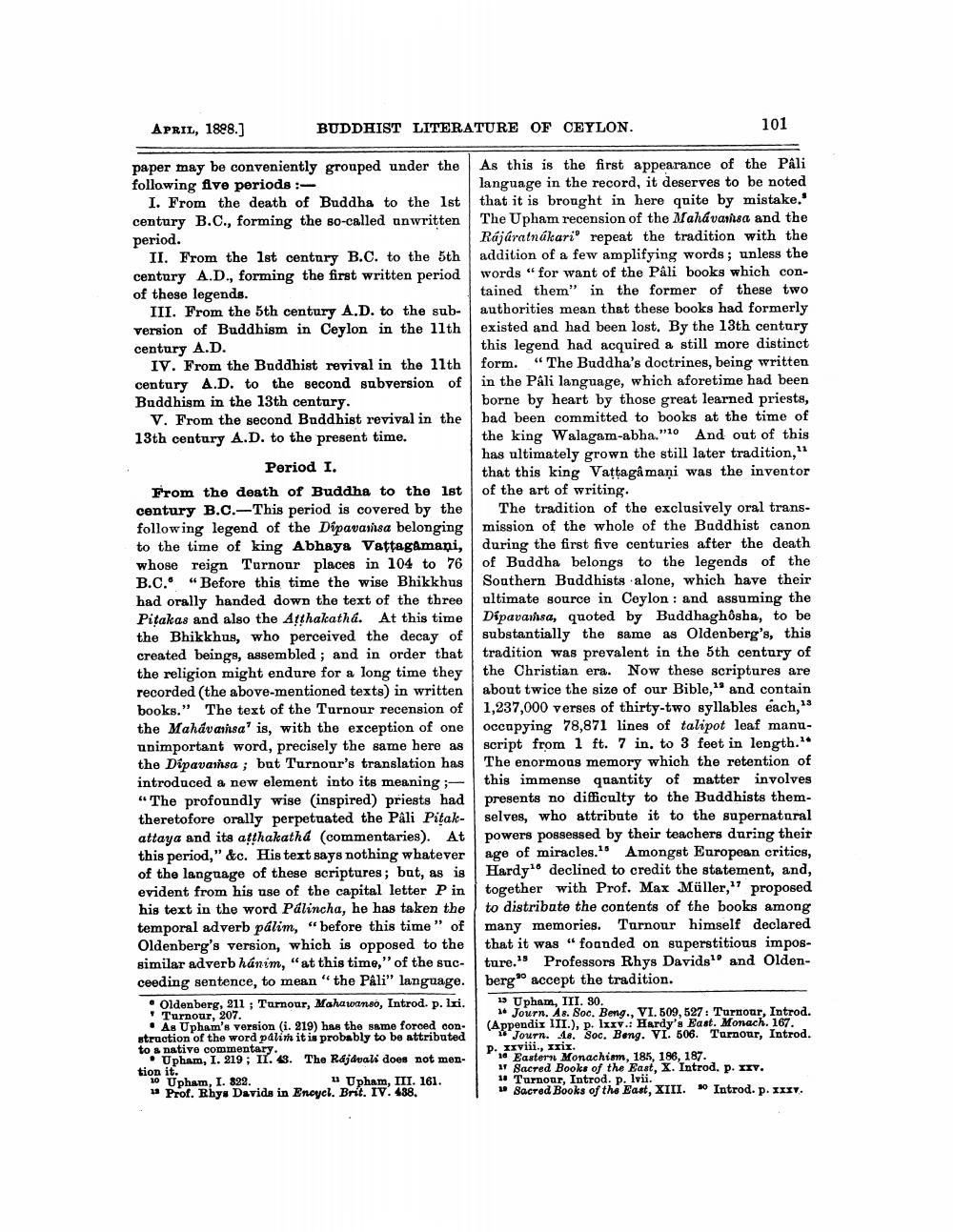________________
APRIL, 1888.]
BUDDHIST LITERATURE OF CEYLON.
101
paper may be conveniently grouped under the As this is the first appearance of the Pali following five periods :
language in the record, it deserves to be noted I. From the death of Buddha to the 1st that it is brought in here quite by mistake." century B.C., forming the so-called unwritten The Upham recension of the Nahávarhsa and the period.
Rájáratnákario repeat the tradition with the II. From the 1st century B.C. to the 5th addition of a few amplifying words; unless the century A.D., forming the first written period words " for want of the Pali books which conof these legends.
tained them" in the former of these two III. From the 5th century A.D. to the sub- authorities mean that these books had formerly version of Buddhism in Ceylon in the 11th existed and had been lost. By the 13th century century A.D.
this legend had acquired a still more distinct IV. From the Buddhist revival in the 11th form. “The Buddha's doctrines, being written century A.D. to the second subversion of in the Pali language, which aforetime had been Buddhism in the 13th century.
borne by heart by those great learned priests, V. From the second Buddhist revival in the bad been committed to books at the time of 13th century A.D. to the present time.
the king Walagam-abha."10 And out of this
has ultimately grown the still later tradition," Period I.
that this king Vattagâ mani was the inventor From the death of Buddha to the 1st of the art of writing. century B.C. This period is covered by the The tradition of the exclusively oral transfollowing legend of the Dipavassa belonging mission of the whole of the Buddhist canon to the time of king Abhaya Vattagamani, during the first five centuries after the death whose reign Turnour places in 104 to 76 of Buddha belongs to the legends of the B.C. "Before this time the wise Bhikkhus Southern Buddhists alone, which have their had orally handed down the text of the three ultimate source in Ceylon : and assuming the Pitakas and also the Atthakatha. At this time Dipavainsa, quoted by Buddhaghôsha, to be the Bhikkhus, who perceived the decay of substantially the same as Oldenberg's, this created beings, assembled ; and in order that tradition was prevalent in the 5th century of the religion might endure for a long time they the Christian era. Now these scriptures are recorded (the above-mentioned texts) in written about twice the size of our Bible," and contain books." The text of the Turnour recension of 1,237,000 verses of thirty-two syllables each," the Mahavainsa' is, with the exception of one occupying 78,871 lines of talipot leaf manuunimportant word, precisely the same here as script from 1 ft. 7 in, to 3 feet in length." the Dipavansa ; but Turnour's translation has The enormous memory which the retention of introduced a new element into its meaning :- this immense quantity of matter involves “The profoundly wise (inspired) priests had presents no difficulty to the Buddhists themtheretofore orally perpetuated the Pali Pitak- selves, who attribute it to the supernatural attaya and its atthakatha (commentaries). At powers possessed by their teachers during their this period," &c. His text says nothing whatever age of miracles. Amongst European critics, of the language of these scriptures; but, as is Hardy" declined to credit the statement, and, evident from his use of the capital letter P in together with Prof. Max Müller," proposed his text in the word Pálincha, he has taken the to distribute the contents of the books among temporal adverb pálim, “before this time" of many memories. Turnour himself declared Oldenberg's version, which is opposed to the that it was founded on superstitious impossimilar adverb hánim, "at this time," of the suc- ture." Professors Rhys Davids' and Oldenceeding sentence, to mean “the Pali" language. bergo accept the tradition. • Oldenberg, 211 ; Turnour, Mahawanso, Introd. p. Isi.
13 Upham, III. 30. Turnour, 207.
** Journ. As. Soc. Beng., VI. 509, 527: Turnour, Introd. • As Upham's version (i. 219) has the same forced con- (Appendix III.), p. mv.: Hardy's East. Monach. 167. struction of the word pålin it is probably to be attributed 1 Journ. 18. Soc. Beng. VI. 506. Turnour, Introd. to & native commentary.
P. IIviii., Ixix. Upham, I. 219; II. 13. The Rájdvali does not men- 10 Eastern Monachism, 185, 186, 187. tion it.
W Sacred Books of the East, X. Introd. p. II. 10 Upham, I. 822.
Upham, III. 161.
Turnour, Introd. p. lvii. 1 Prof. Rhys Davide in Encycl. Brit. IV. 488,
Sacred Books of the East, XIII. * Introd. p. IIXV.




